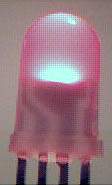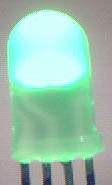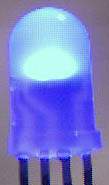Tricolor RGB 10mm LED from Unitech/LC LED Systems, $1.89
Received 01-29-10, tested 01-31-10
This is an RGB LED, but unlike all others to have crossed my bench, this one comes in a 10mm water-clear epoxy body.
Chemistry is:
InGaAlP red (~654nm)
InGaN green (~522 nm)
InGaN blue (~460nm) .
This appears to be their part number M810RGB4E.
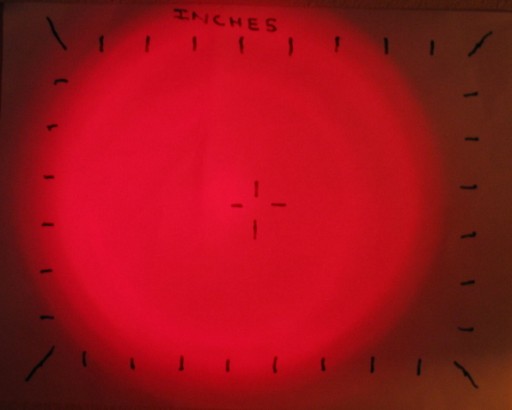
Beam photograph on the test target at ~12" (red die).
Measures 2,520mcd on a Meterman LM631 (now Amprobe LM631A) light meter.

Beam photograph on the test target at ~12" (green die).
Measures 5,120mcd on a Meterman LM631 (now Amprobe LM631A) light meter.

Beam photograph on the test target at ~12" (blue die).
Measures 2,610mcd on a Meterman LM631 (now Amprobe LM631A) light meter.

Spectrographic analysis of this LED (red die).

Spectrographic analysis of this LED (red die); spectrometer's response narrowed to 630nm to 680nm.
Peak wavelength appears to be 654.80nm.
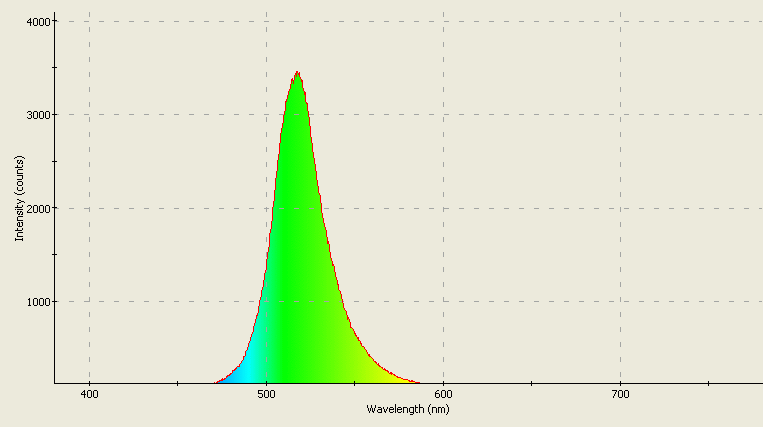
Spectrographic analysis of this LED (green die)

Spectrographic analysis of this LED (blue die).
5mm flashing RGB LED, $TBA
Received 06-14-05, tested 06-15-05
This is a 5mm water-clear epoxy bodied LED that was sent to me by a fan of this website. It is an RGB LED that flashes all by itself using a circuit that's built into the LED itself.
The flashing pattern kind of goes like this: Steady red, followed by a fade to blue, switching to red again, fade to green, switching to red again, repeat once. Green, fading to red, fading to blue, switch to green, blinking to red, and some pattern I have yet to identify.
The dominant wavelengths (where you would point to on a color chart) of the three dice inside appear to be approximately 468nm (blue), 525nm (green), and 640nm (red).

Photograph of the LED itself in the test set.
Because of the nature of its flashes, I cannot furnish a beam photograph for you.
Because this is a flashing lamp, I cannot measure its intensity or current consumption.
The LED appears to have a viewing angle of 14-18°.
5mm Water-Clear Flashing RGB LED, LEDSET.COM
(Received 01-26-05, tested 02-01-05)
This is a self-flashing RGB (red, green, blue) LED. It comes in a water-clear, 5mm (T1 3/4) case, and it has two leads, much like an ordinary LED does.
When power is applied, the LED does a color wash thing, then approximately seven seconds later, starts flashing, then approximately seven seconds later, the cycle repeats. All on its own, with no user intervention required.
Figure this LED will require at least 3.6 volts to operate properly, and at least 4.0 volts for reliable operation.
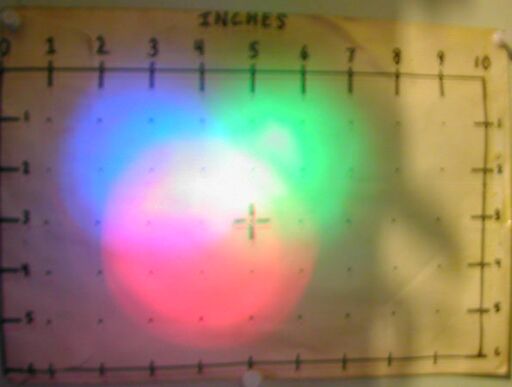
Because this is a self-flashing lamp, I cannot take voltage, current, or intensity measurements.
Movie (.MOV format) of this LED in action.
File may take up to 25 minutes to download on a 48.0Kbps dial-up connection.
WMP movie (.avi extension) - same as above, just different in format.
This clip is approximately 1.88 megabytes (1,991,680 bytes) in length; dial-up users please be aware.
It will take no less than seven minutes to load at 48.0Kbps.
ETG, Milky Diffused RGB Flashing LED, part # ETG-5AX-RGB-ICR1
Received on 01-17-04, tested on 01-17-04
This is a self-flashing RGB (Red-Green-Blue) 5mm LED in a diffused, milky case. The sequence starts as a red/green/blue fade over a couple of seconds, then the individual colors fade on and stay at full intensity for about five seconds each: red, green, blue, yellow (red and green chips together), cyan (green and blue chips together), purple (blue and red chips together), and then white (all three chips on together). Then there's a brief sequence I cannot yet identify. Once complete, the sequence then repeats, except that the fade at the beginning is skipped. If power is interrupted during any part of the cycle, the sequence begins again from the start, including the two second or so fade at the very beginning.
The milky, diffused case does help mix the colors within the LED much better than a transparent case would.

I don't know much about these LEDs, so I don't have a lot of information about them for this page.
Same goes with current and voltage requirements. The LED does not stay in a steady state long enough to get a reading. Figure on feeding it around 3.6 volts at 20 or 30mA. Go much higher and you'll probably let the magic smoke out of it and it'll blow up.
NOTE: There are no beam photos or intensity measurements because this is a diffused lens LED, and I'm not equipped to take beam photos or intensity measurements of diffused lens LEDs.
Chi Wing 5mm RGB Pixel LED, (http://stores.ebay.com/chiwingledproductshop)
(Rec'd 12-24-2003, tested 01-01-2004)
A fan of the website sent me a box of goodies (like batteries, LEDs, flashlights, and a laser); and 3 of these LEDs were among the goodies.
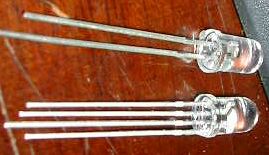
Here's what the LED itself looks like. It's the one on the bottom with 4 leads.
This is a Chi Wing "RGB Pixel" LED, which comes in a water-clear 5mm epoxy case, and has three independently controllable chips (dice) inside. There's a red, a green, and a blue die in the same casing, wired so the cathode (-) connection is common to them all, and the anodes (+) are connected to the individual dice inside the LED body so you can control them all independently.
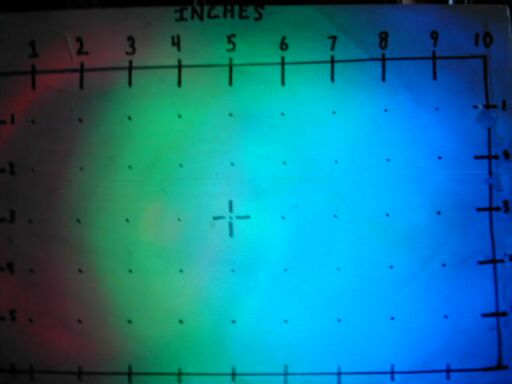
I don't have any intensity measurements...yet anyway.
When all the dice are fired up from the same 10mA source (a Hosfelt LED tester with multiple sockets of the same current output for comparative analyses), it appears to emit a blue-green (cyan) light, with comparatively little output in the red. The beam photograph above was taken using the LED in this configuration.
According to an LED guru who's work I trust, this behaviour is perfectly normal, and is nothing to be concerned about.
To get a more white color out of this or other RGB LEDs, use the following currents:
-
Red - 25 mA
Green - 15 mA
Blue - 8 mA
ETG, model # ETG-5SE-RGB-IC, flashing RGB, $3.50 each for small qty
(08-15-02)
Part number look familiar?
Thought so. This RGB flasher LED just arrived, and it appears to be a replacement for the LED shown directly below. Instead of a blob of melted broken toliet (porcelain or ceramic) on the base, this LED is built to be mechanically identical to an ordinary 5mm LED, including having standard rectangular profile leads like most modern LEDs have.
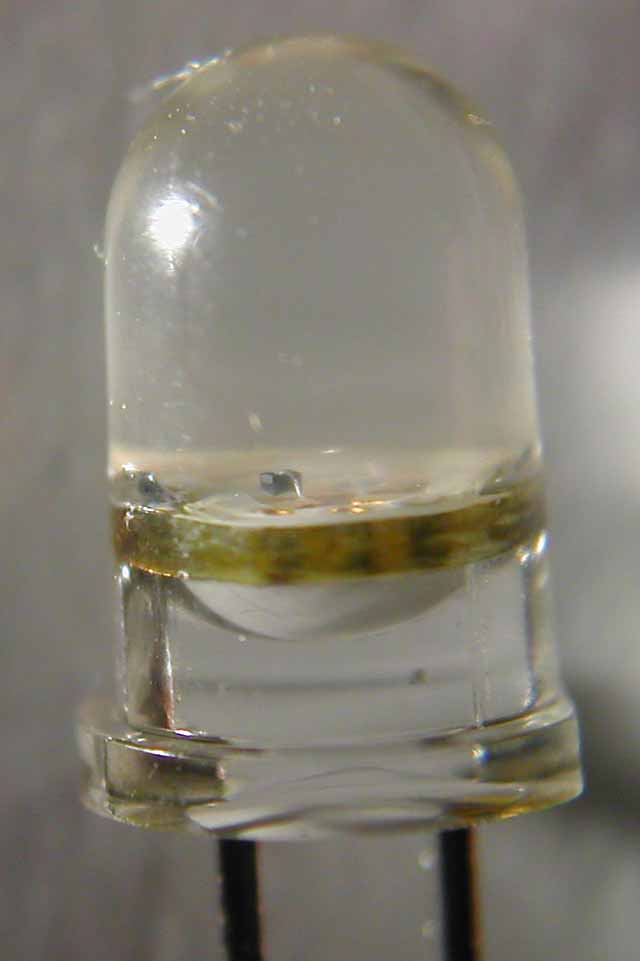
As you can see, this LED can be used as a direct replacement for any ordinary 5mm LED, but it definitely doesn't behave like one. It has a series of flash/fade modes programmed into it, so all you do is feed it a few volts, and let it do the driving.
The exact sequence is: Series of quick flashes; red, green, blue, red+green, green+blue, blue+red, and then all three at once. It repeats this fast cycle 2 times. Next, the red fades on, stays on for about 2 seconds, then fades out. Same with green, then blue, then red+green, green+blue, blue+red, and then all three. It does this slow fade for two entire cycles; then everything begins again. Figure it takes a bit under a minute to complete the entire sequence and then recycle. If it is interrupted at any time, it restarts from the beginning as soon as you apply power again.
When driven to 20-25mA, the voltage drop ranges from 2.94v with all segments lit, to around 3.6 volts with only the green segment lit. Figure to supply it with at least 3.6 volts, but not much over that. Resistor it as you would a Nichia green, blue, or white LED (or any other high Vf gallium nitride lamp); and it won't give you any guff.
ETG, model # ETG-5SE-RGB-IC, flashing RGB, see above for newer version
(07-12-02)
A week ago, I received a strange little "LED" lamp from ETG; it was a fully self-contained RGB LED flasher. (See below). Today, another RGB flasher LED showed up; and this one is more unusual than the last. This one comes in what looks like a standard sized, T1 3/4 (5mm) clear epoxy package with the flasher circuit and LED chips attached to the base with some kind of ceramic-looking compound.

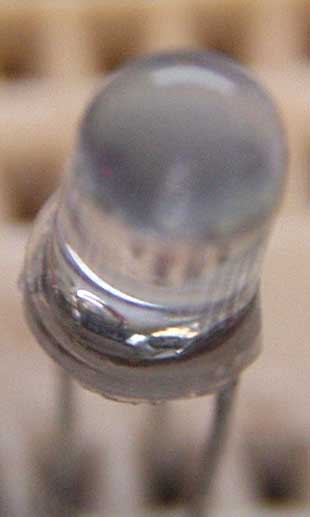
This LED has three leads; and I'm honestly not 100% sure what they're all for. Two of them are obviously the power leads; the third one may be a control input of some kind. As I experimented with the LED, I was able to make it change flashing modes by plugging and unplugging it, and by touching the tip of another resistor connected to B+ to the third lead. I will await a pinout from my friend at ETG before I risk ruining this unusual lamp. Some things you can't un-do. You can't un-strike a match. You can't un-peel a tomato. You can't un-flush a toliet. And you can't un-blow a blown LED.
ETG, model # ETG-2SE-RGB-IC, flashing RGB, price/availability not yet known
(Rec'd approx. 07-01-02)
Do you know a true "LED nutcase"? Someone who loves things that glow, and is eager to see all the new LED products as they emerge on the market? Want to make his eyes bug out like somebody switched The Price Is Right with a porno flick right in the middle of Plinko or Hole in One or Two? Then show him one of these!

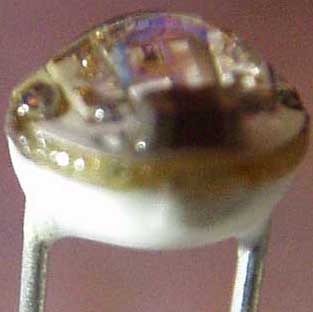
Close-ups of this unique RGB flasher
Although it is labelled as a "flashing LED" and it's the same diameter as an ordinary LED, if you look closely you can see some SMD parts and some other structures inside the epoxy dome. I don't see an exposed IC; it actually appears the flasher circuit is three seperate ICs, each one mounted inside a tiny ceramic block, and each with an LED die mounted to its top. It is also possible that the IC is a larger device and is mounted underneath the visible components. In any case, this very interesting component is actually a complete, microminiature PCB with flasher circuit and three LED chips, all encased in a discrete, LED-like ceramic & epoxy package.

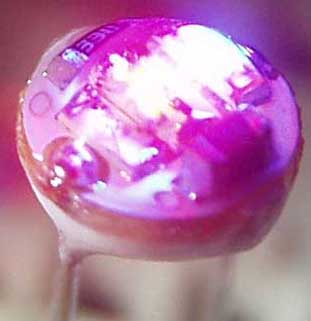
A couple of "action" shots.
The LEDs don't just flash. The IC is programmed with several effects, which cycle in sequence. It starts with a medium speed back-and-forth color fade, then goes to a slower, unidirectional color fade, then each LED flashes individually in sequence, then there's a pseudo-random thing where all the chips flash in some kind of alternating pattern. This last mode was too fast for me to determine the exact sequence of flashes, so let's just say it was neat. ;) Then the whole thing repeats.
According to the manufacturer, this "LED" should be treated like any other GaN LED, and its forward voltage kept at 3.6v. At that voltage, average current should be in the neighborhood of 30mA, though it is tricky to measure because the LED states keep changing.
The other item of note is the lead spacing is a little wider than is usual for a typical 5mm LED, and the leads are round in profile; rather than being rectangular (2x4 shaped) like an ordinary 5mm through-hole LED's leads are.
Nichia, model NSTM515S, true RGB, $20-$24 apiece
In late 1999, several of these rather pricey specialty LEDs became available to me for testing. A special jig had to be made in order to get them hooked up right and tested.
Are you looking for a nice LED for one of your projects, but just aren't sure what color you want it? Or ever built something with an LED in it and then later decided you hated the LED color?
Then maybe you should try one of these. This LED is in a milky white, rather ordinary looking T1 3/4 case, which has FOUR (4) leads coming out of the bottom. The anode (+) connection is the common; the other three are the cathode (-) connections for the individual red, green, and blue chips inside.
When connected to a power source and pots (variable resistors) are added to each cathode, you can make this LED turn virtually any color you can imagine with the turn of a few tiny knobs. While I'm sitting here writing this, I'm screwing with the knobs on my test jig and making all sorts of interesting and unusual colors come out of mine. Whte balance not quite right? Then add a touch more red, or take out a hint of green. Want to make it look like the color of Barney the Dinosaur's fur? No problem. If any FUN could come out of playing with LEDs, this is the one that'll do it.
Theoretically, this LED should be able to reproduce virtually any color that a conventional video system can generate, using the individual red, green and blue chips to do so. They are designed to operate much like an individual pixel triad in the picture tube of a TV set or computer monitor; with the potential to create any of some unnumbered thousands of individually distinguishable colors.
This particular type of LED is likely to be found in smaller video display boards, such as those 5' to 8' presentation screens used in lecture halls, trade shows, or auditoriums.
Larger video boards such as those found in sports stadiums generally use discrete red, green, and blue LEDs arranged into pixel triads rather than these LEDs because larger screens need more brightness.
The overall brightness of this particular LED can vary considerably, depending on what particular color & hue you're after. The manufacturer Nichia advises that you must keep total operating power at or below 120 milliwatts when lighting up more than two of the three chips - so you can't run all three at their individual maximim ratings for long, or the poor thing will likely overheat, suffer a reduced lifetime, or blow one or more color chips. And unless you have the $20+ to drop on just a single one of these, I'd take their advice to heart.

